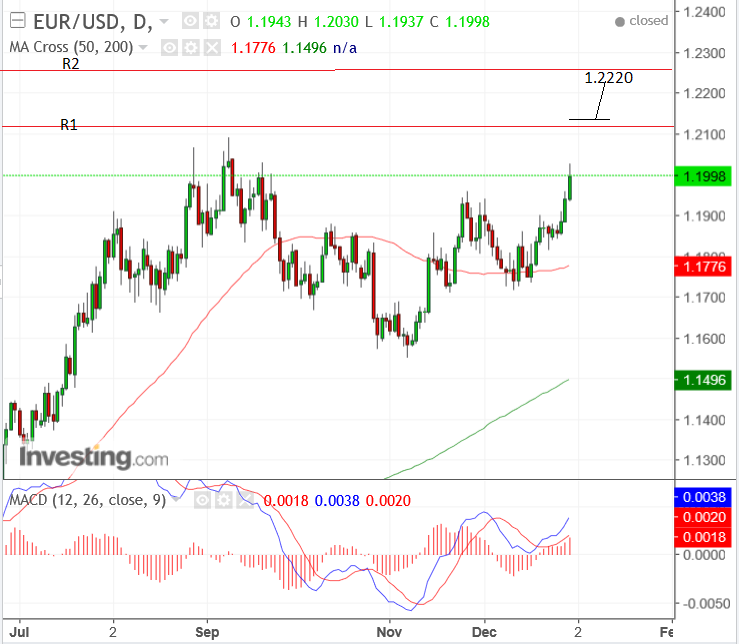The Euro-to-Dollar Rate in the Coming Week Including Technical Forecast, Data, and News

The chart of the Euro-to-Dollar is showing bullish potential, and in the week ahead US jobs data vies with Eurozone sector activity data as the most important drivers of the exchange rate.
The Euro-to-US Dollar rate has resumed its uptrend in December, rising from 1.1700 to 1.2000 in the process, and it looks likely to continue judging by the longer-term charts such as the monthly chart below, which clearly shows the longer-term uptrend since the late 2016 lows.
This longer-term uptrend is still essentially intact after correcting back over the last few months following an encounter with resistance from the formidable 50-month moving average, at 1.1746.

However, this pull-back looks to be only a temporary correction before the exchange rate starts to climb higher again.
The MACD momentum indicator is also rising at the same as price action which is a posiitve sign for the exchange rate.
Momentum is also above the key zero-line distinguishing an uptrend from a downtrend indication.
A break above the late September highs at 1.2098 would help to confirm a continuation higher, however, the R1 monthly pivot at 1.2113 could prove a tough obstacle to further upside and we would ideally like to see a clear break above it - signalled by a move above 1.2140 - for confirmation of a continuation higher, towards a target at 1.2220, which is just below R2.
Monthly pivots can be an obstacle to further upside since traders often anticipate resistance at these levels, which leads to increased order flow as speculators attempt to make a quick profit on the expected pull-back.

Get up to 5% more foreign exchange by using a specialist provider by getting closer to the real market rate and avoid the gaping spreads charged by your bank for international payments. Learn more here.
Data and Events for the US Dollar
Probably the most important release in the week ahead is the US Bureau of Labour Statistics monthly report on the state of the labour market, also known as Non-Farm Payrolls (NFPs), which is out at 13.30 GMT on Friday, January 5.
The NFP headline figure shows the number of new jobs filled in the last month, in this case, December.
There are also other important data components contained within the report, including average hourly earnings, private payrolls, the unemployment rate and the participation rate, which measures what percentage of the population is actively seeking work.
It is important to the Dollar because it is an indicator of inflation pressures since the more people who are in work and earning money, the more they tend to spend that money and the more inflation tends to go up.
Higher inflation tends to lead to higher interest rates, which increase inflows of foreign capital, drawn by the promise of higher returns, and this increases demand for the currency, driving up its value.
Friday's NFP result is expected to see a result of 187k new jobs, down from 228k in November, yet even a result in the 180s will still be seen as strong given the fact unemployment is currently at historic lows, so any increase in take-up of new jobs above about 100k is viewed as positive.
Average hourly earnings may be more important to the Dollar because relatively subdued earnings growth has kept the inflationary impact of high employment at bay, so changes to earnings are more important now than jobs; these are expected to show a 0.3% rise from 0.2% in the previous month of November.
"We expect payrolls to moderate to a 170k after two consecutive gains north of 200k. An unchanged unemployment rate and a stronger 0.3% m/m wage gain argue for an upbeat report on balance, though the latter should leave earnings stable on a y/y basis," remarks Canadian investment bank TD Securities in relation to the release.
The other main releases in the coming week for the US Dollar are manufacturing and services sector PMIs, which are surveys of key purchasing managers in major sectors of the economy to assess their level of activity.
The US manufacturing PMI for December is out on Tuesday, January 2 at 14.45 GMT.
The Services PMI, meanwhile, is out at the same time on Thursday, January 4.
Data and Events for the Euro
The main release for the Euro in the week ahead is Eurozone inflation data for December, which is out at 10.00 GMT on Friday, January 5.
Inflation data is forecast to remain unchanged at 1.4% but if it rises above what is expected then it will support the Euro, and vice versa if it falls.
Higher inflation tends to lead to higher interest rates which attract more inflows of foreign capital, drawn by the promise of higher returns, and this, in turn, strengthens the currency.
The other main set of release in the coming week is key purchasing manager survey data assessing the health of the two main sectors of Manufacturing and Services in December.
Manufacturing PMI, as it is known, is out at 9.00 GMT on Tuesday, December 2 and is forecast to stay unchanged from November at 60.6.
Services PMI is out at 9.00 on Thursday and is forecast to stay at 56.6.





